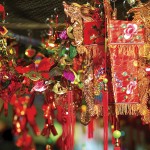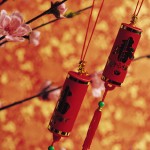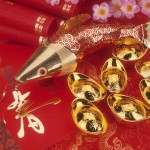 The Chinese New Year, or Spring Festival as it’s been called since the 20th century, remains the most important social and economic holiday in China. Originally tied to the lunar-solar Chinese calendar, the holiday was a time to honor household and heavenly deities as well as ancestors. It was also a time to bring family together for feasting. With the popular adoption in China of the Western calendar in 1912, the Chinese joined in celebrating January 1 as New Year’s Day. China, however, continues to celebrate the traditional Chinese New Year, although in a shorter version with a new name–the Spring Festival. Significantly, younger generations of Chinese now observe the holiday in a very different manner from their ancestors. For some young people, the holiday has evolved from an opportunity to renew family ties to a chance for relaxation from work.
The Chinese New Year, or Spring Festival as it’s been called since the 20th century, remains the most important social and economic holiday in China. Originally tied to the lunar-solar Chinese calendar, the holiday was a time to honor household and heavenly deities as well as ancestors. It was also a time to bring family together for feasting. With the popular adoption in China of the Western calendar in 1912, the Chinese joined in celebrating January 1 as New Year’s Day. China, however, continues to celebrate the traditional Chinese New Year, although in a shorter version with a new name–the Spring Festival. Significantly, younger generations of Chinese now observe the holiday in a very different manner from their ancestors. For some young people, the holiday has evolved from an opportunity to renew family ties to a chance for relaxation from work.
The Ancient Chinese Calendar:
The ancient Chinese calendar, on which the Chinese New Year is based, functioned as a religious, dynastic and social guide. Oracle bones inscribed with astronomical records indicate that it existed at least as early as 14th century B.C., when the Shang Dynasty was in power. The calendar’s structure wasn’t static: It was reset according to which emperor held power and varied in use according to region.
Did You Know?
San Francisco, California, claims its Chinese New Year parade is the biggest celebration of its kind outside of Asia. The city has hosted a Chinese New Year celebration since the Gold Rush era of the 1860s, a period of large-scale Chinese immigration to the region.
The Chinese calendar was a complex timepiece. Its parameters were set according to the lunar phases as well as the solar solstices and equinoxes. Yin and yang, the opposing but complementary principles that make up a harmonious world, also ruled the calendar, as did the Chinese zodiac, the cycle of twelve stations or “signs” along the apparent path of the sun through the cosmos. Each new year was marked by the characteristics of one of the 12 zodiacal animals: the rat, ox, tiger, rabbit, dragon, snake, horse, sheep, monkey, rooster, dog and pig.
The Traditional Chinese New Year:
The Chinese New Year period began in the middle of the 12th month and ended around the middle of the first month with the waxing of the full moon. Observance of the New Year period was traditionally divided into New Year’s Eve and the first days of the new year.
 Traditionally for the Chinese, New Year was the most important festival on the calendar. The entire attention of the household was fixed on the celebration. During this time, business life came nearly to a stop. Home and family were the principal focuses. In preparation for the holiday, homes were thoroughly cleaned to rid them of “huiqi,” or inauspicious breaths, which might have collected during the old year. Cleaning was also meant to appease the gods who would be coming down from heaven to make inspections. Ritual sacrifices of food and paper icons were offered to gods and ancestors. People posted scrolls printed with lucky messages on household gates and set off firecrackers to frighten evil spirits. Elders gave out money to children. In fact, many of the rites carried out during this period were meant to bring good luck to the household and long life to the family–particularly to the parents.
Traditionally for the Chinese, New Year was the most important festival on the calendar. The entire attention of the household was fixed on the celebration. During this time, business life came nearly to a stop. Home and family were the principal focuses. In preparation for the holiday, homes were thoroughly cleaned to rid them of “huiqi,” or inauspicious breaths, which might have collected during the old year. Cleaning was also meant to appease the gods who would be coming down from heaven to make inspections. Ritual sacrifices of food and paper icons were offered to gods and ancestors. People posted scrolls printed with lucky messages on household gates and set off firecrackers to frighten evil spirits. Elders gave out money to children. In fact, many of the rites carried out during this period were meant to bring good luck to the household and long life to the family–particularly to the parents.
Most important was the feasting. On New Year’s Eve, the extended family would join around the table for a meal that included as the last course a fish that was symbolic of abundance and therefore not meant to be eaten. In the first five days of the New Year, people ate long noodles to symbolize long life. On the 15th and final day of the New Year, round dumplings shaped like the full moon were shared as a sign of the family unit and of perfection.
Evolution of Spring Festival:
The Western-style Gregorian calendar arrived in China along with Jesuit missionaries in 1582. It began to be used by the general population by 1912, and New Year’s Day was officially recognized as occurring on January 1. Beginning in 1949, under the rule of Chinese Communist Party leader Mao Zedong (1893–1976), the government forbade celebration of the traditional Chinese New Year and followed the Gregorian calendar in its dealings with the West. But at the end of the 20th century, Chinese leaders were more willing to accept the Chinese tradition. In 1996, China instituted a week-long vacation during the holiday–now called Spring Festival–giving people the opportunity to travel home and to celebrate the new year.
 In the early 21st century, many Chinese families spent a significant amount of their discretionary income celebrating the Spring Festival with traditional symbols and food. They also spent time watching the televised Spring Festival Gala: an annual variety show featuring traditional and contemporary singers, dancers and magic demonstrations. Although the rites of the holiday no longer had religious value, people remained sensitive to the zod
In the early 21st century, many Chinese families spent a significant amount of their discretionary income celebrating the Spring Festival with traditional symbols and food. They also spent time watching the televised Spring Festival Gala: an annual variety show featuring traditional and contemporary singers, dancers and magic demonstrations. Although the rites of the holiday no longer had religious value, people remained sensitive to the zod
We want our community to be a useful resource for our users but it is important to remember that the community is not moderated or reviewed by doctors and so you should not rely on opinions or advice given by other users in respect of any healthcare matters.
Always speak to your doctor before acting and in cases of emergency seek appropriate medical assistance immediately. Use of our community is subject to our Terms of Use and Privacy Policy and steps will be taken to remove posts identified as being in breach of those terms.
